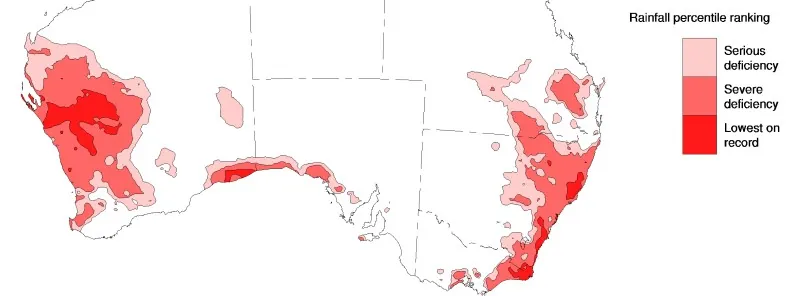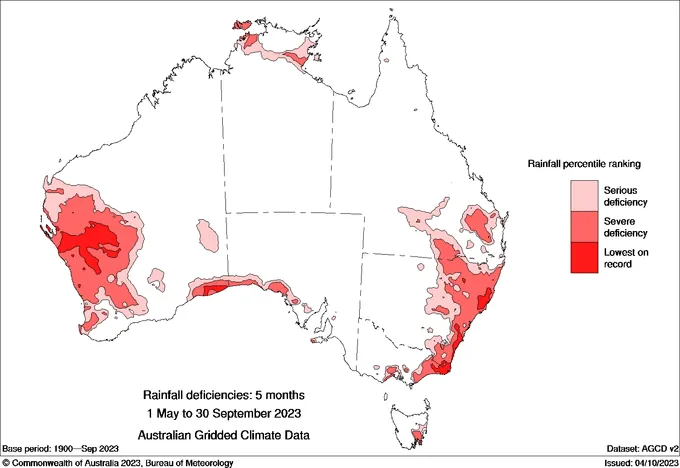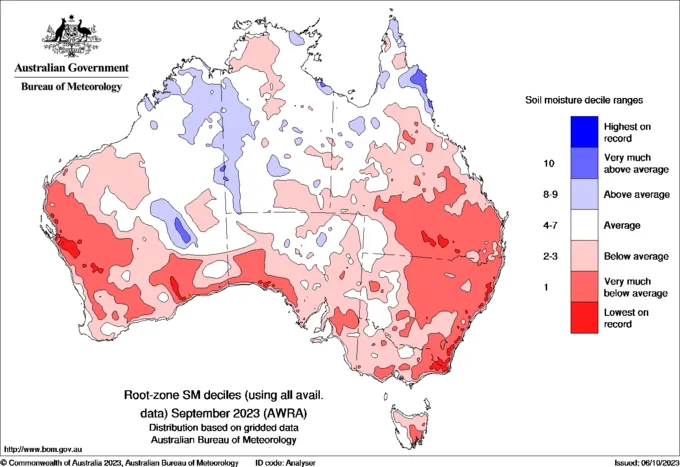Australia experiences driest September on record, endangering agricultural production

Areas of severe rainfall deficiency are expanding in Australia, following the country’s driest September on record (since 1900), affecting the nation’s farm production and contributing to a 41% predicted fall in average farm incomes in the 2023–24 financial year.
Australia’s Bureau of Meteorology reported on October 6, 2023, that the country witnessed the driest September on record, increasing concerns for the agricultural sector. Rainfall nationwide in September was 70.8% below the average measured between 1961 – 1990. The severe dry spell is part of an El Nino weather pattern, known to bring hotter and drier conditions.
Farmers in parts of southeastern Australia did experience some relief through recent rainfalls, yet the overall impact on the country’s wheat harvest has been negative. The Australian government has indicated that average farm incomes are projected to plummet by 41% in the fiscal year 2023–24.
For the five months since May 2023, all Australian states and territories have seen areas of rainfall deficiencies. Notable regions include large parts of south-west Western Australia and much of the country’s south-east. “Areas of deficiency have generally expanded and become more severe, and new areas have emerged, including along the West Coast district in South Australia and in the Central district in Victoria,” the Bureau said.

In addition, soil moisture levels in September were recorded as below average for much of Australia, ranking in the lowest 30% since 1911, except for northern and central inland areas. Data from New South Wales revealed that although only 3.5% of the state is officially in drought, an additional 28.2% falls under the drought-affected category, indicating weakened agricultural conditions.

Low streamflows were observed mostly at sites in the south and south-eastern New South Wales, south-eastern Queensland, scattered sites in the southwest of Western Australia, and most sites in Victoria and Tasmania.
Storage levels remain low in some parts of southern and central Queensland, south-eastern parts of New South Wales, central Tasmania, and urban areas of Perth.
For November 2023 to January 2024, below median rainfall is likely to very likely (60% to greater than 80% chance) for much of western, northern, and southern Australia, with small areas of northern New South Wales having a slightly increased chance of above median rainfall.
Significant rainfall in eastern Victoria and parts of south-east New South Wales in the first week of October is likely to ease localized rainfall and soil moisture deficiencies and will be documented in the October Drought Statement.
References:
1 Driest September on record for Australia – BOM – October 6, 2023
Featured image credit: BOM

Commenting rules and guidelines
We value the thoughts and opinions of our readers and welcome healthy discussions on our website. In order to maintain a respectful and positive community, we ask that all commenters follow these rules.